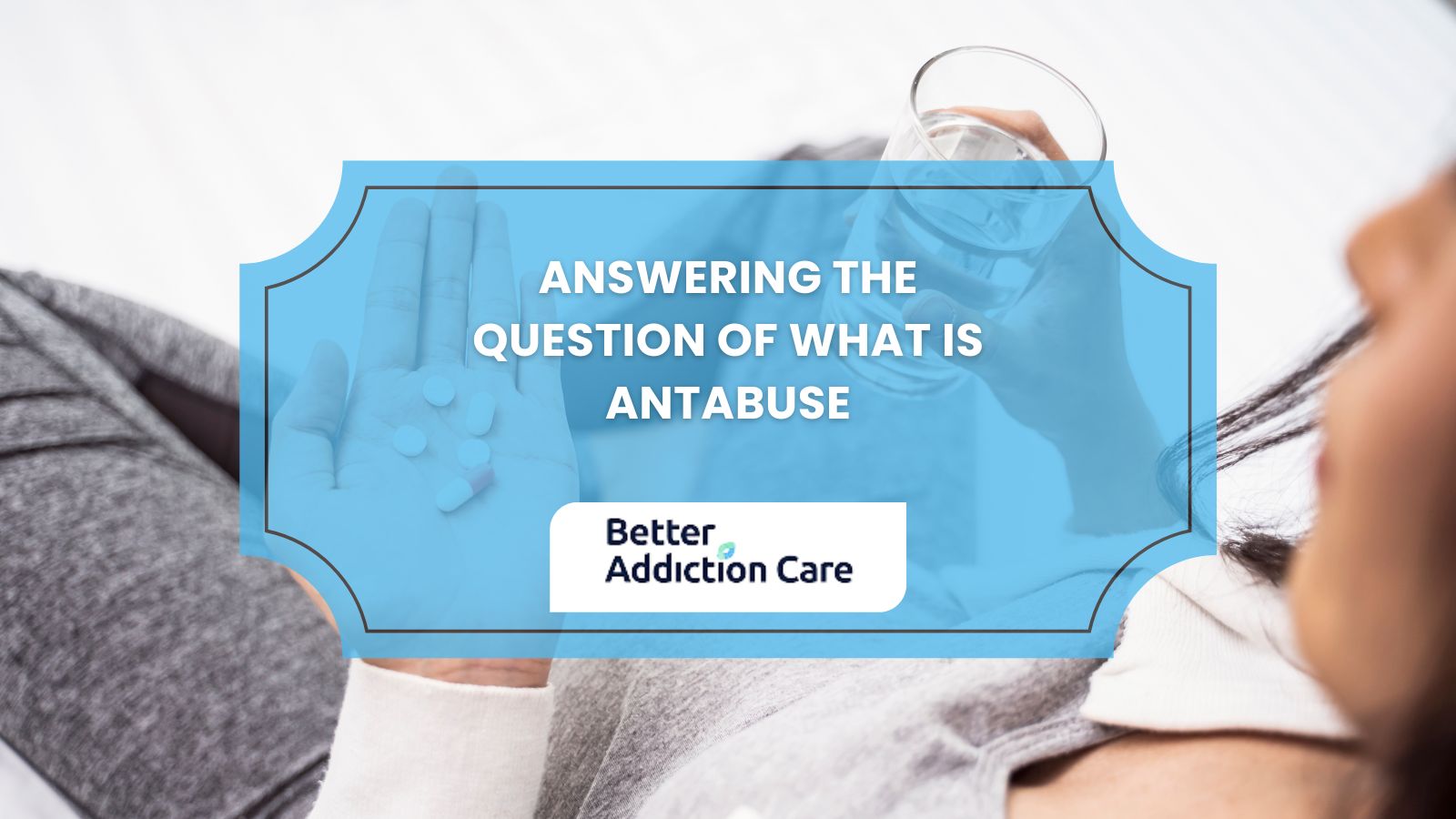How Long Do Alcohol Cravings Last?
Alcohol cravings last between 3 to 30 minutes for a single craving, but the frequency and intensity can persist for weeks or even months depending on individual recovery progress. One of the most challenging aspects of early recovery is the uncertainty. Cravings make you feel confused, intrusive, and persistent, even after weeks or months of not drinking. Finding out what’s happening in the brain and body removes some of that uncertainty and offers a path forward.
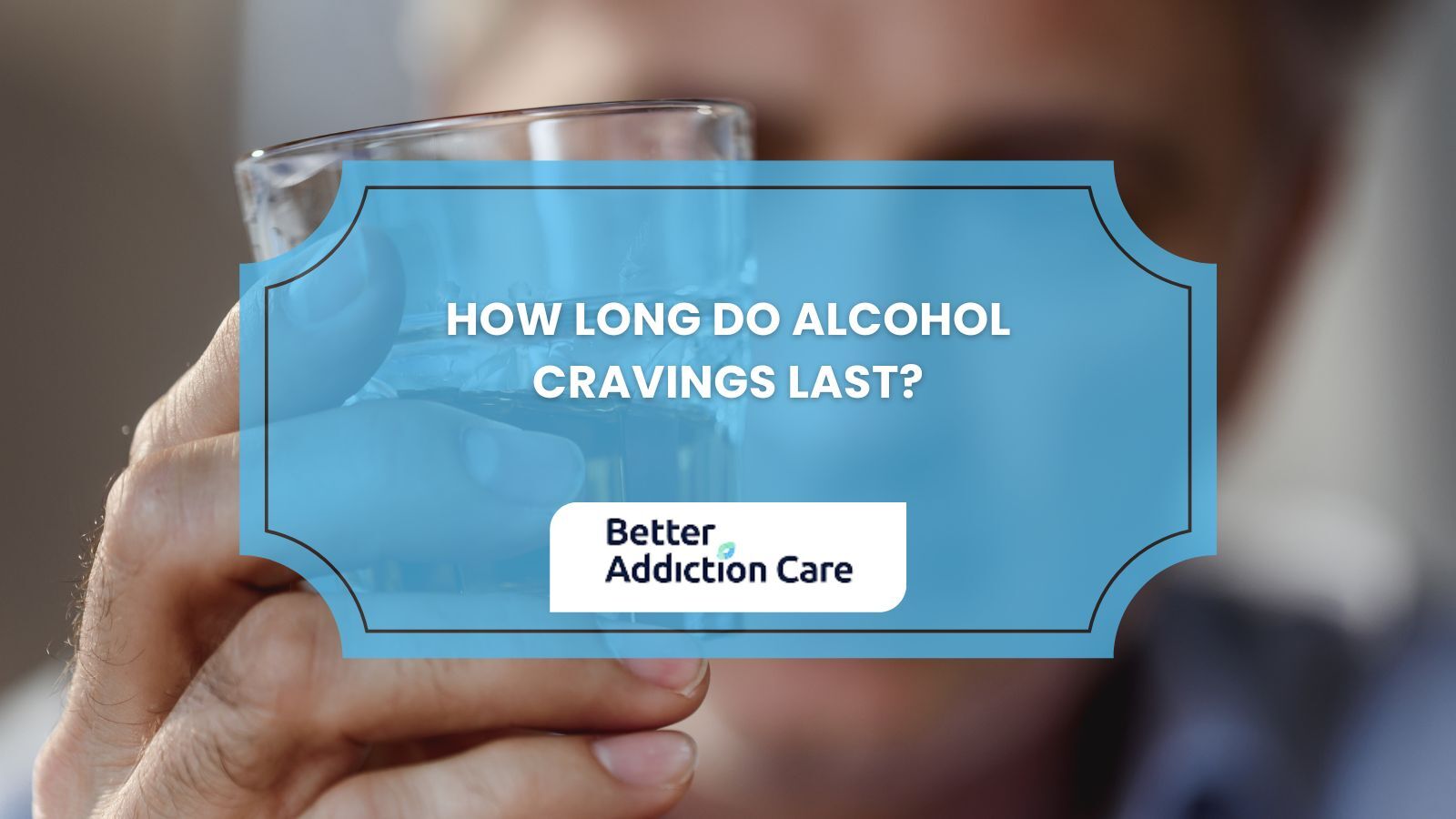
In reality, cravings aren’t a sign of failure. A study by Andri Rennwald and Michael P. Hengartner, titled "Post-acute withdrawal syndrome (PAWS) after stopping antidepressants: a systematic review with meta-narrative synthesis", published in 2025 in the journal Epidemiology and Psychiatric Sciences, found that post-acute withdrawal symptoms, including cravings, persist for 4 – 6 months or longer, with some cases extending up to several years depending on individual factors and substance type.
These are signs that the brain is working to heal. And while they feel overwhelmed at the moment, they do follow a predictable arc, and they get easier to manage with time, support, and strategy.
Key Takeaways:
-
Alcohol cravings follow predictable phases with specific timelines: Cravings typically appear about 3 days after stopping alcohol consumption and intensify by about 5 to 7 days after the last drink, but the complete picture extends far beyond the initial weeks. Understanding these precise phases helps individuals in recovery set realistic expectations and develop targeted coping strategies.
-
Three distinct craving phases require different approaches: Acute cravings (days 1-14) are primarily physical and neurochemical. Post-acute cravings (weeks 2-26) involve complex brain rewiring processes. Long-term psychological cravings can emerge sporadically for months or years, triggered by environmental and emotional factors rather than physical dependence.
-
Individual factors significantly influence craving duration and intensity: Duration of alcohol use, quantity consumed, age, overall health, co-occurring mental health conditions, and support systems all impact how long cravings persist. Heavy daily drinkers may experience intense cravings for 6-12 months, while moderate users might see significant improvement within 8-16 weeks.
Why Do Alcohol Cravings Happen?
Alcohol cravings happen due to changes in brain chemistry, habit formation, and environmental or emotional triggers that activate the brain’s reward system and reinforce the desire to drink.
Alcohol Cravings aren’t just habits or thoughts; they’re deeply rooted in neurobiology.
What is the Brain’s Chemistry Behind Alcohol Cravings?
The brain’s chemistry behind alcohol cravings is prominent when alcohol disrupts the brain’s natural balance. It artificially increases dopamine and numbs stress, while at the same time teaching the brain to rely on alcohol for those effects.
When alcohol use stops, the brain goes through a period of chemical imbalance, leading to intense urges as it struggles to recalibrate.
The part of the brain responsible for logic and decision-making, the prefrontal cortex, also becomes impaired during this time, making it harder to resist cravings through willpower alone.
Listed below are 3 Phases of Alcohol Craving.
-
Phase 1: Acute Cravings (Day 1 -14)
-
Phase 2: Post-Acute Withdrawal Syndrome (Week 2 - 26)
-
Phase 3: Long Term Psychological Cravings ( 6 months +)
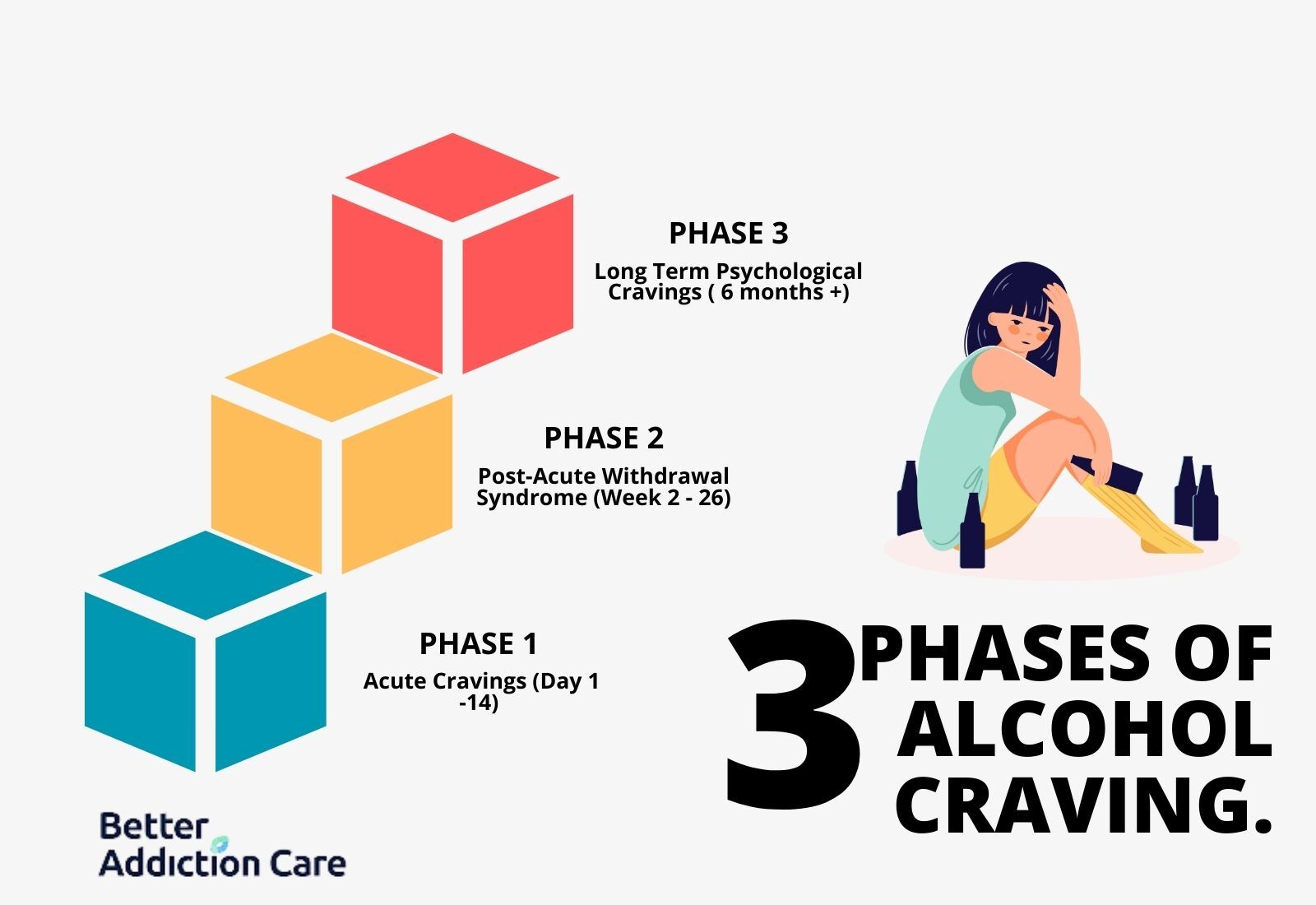
Phase 1: Acute Cravings (Days 1-14) - The Physical Storm
Alcohol withdrawal begins within eight hours after the last drink, with symptoms usually peaking within 24 to 72 hours. This is when cravings are most physically intense and potentially dangerous.
A study by Emmanuelle Baillet et al., titled "Craving changes in first 14 days of addiction treatment: an outcome predictor of 5 years substance use status", published in 2024 in the journal Translational Psychiatry, used Ecological Momentary Assessment (EMA) to track craving intensity during the first two weeks of treatment.
The researchers found that daily fluctuations in craving during this acute phase were predictive of long-term substance use outcomes. Specifically, individuals with a slower decrease in craving intensity and lower craving inertia (i.e., cravings that persisted longer) were more likely to relapse over a 5-year period
What's happening in your brain? The brain is in crisis mode, desperately seeking chemical balance. Neurotransmitter production is chaotic, creating intense physical and psychological distress.
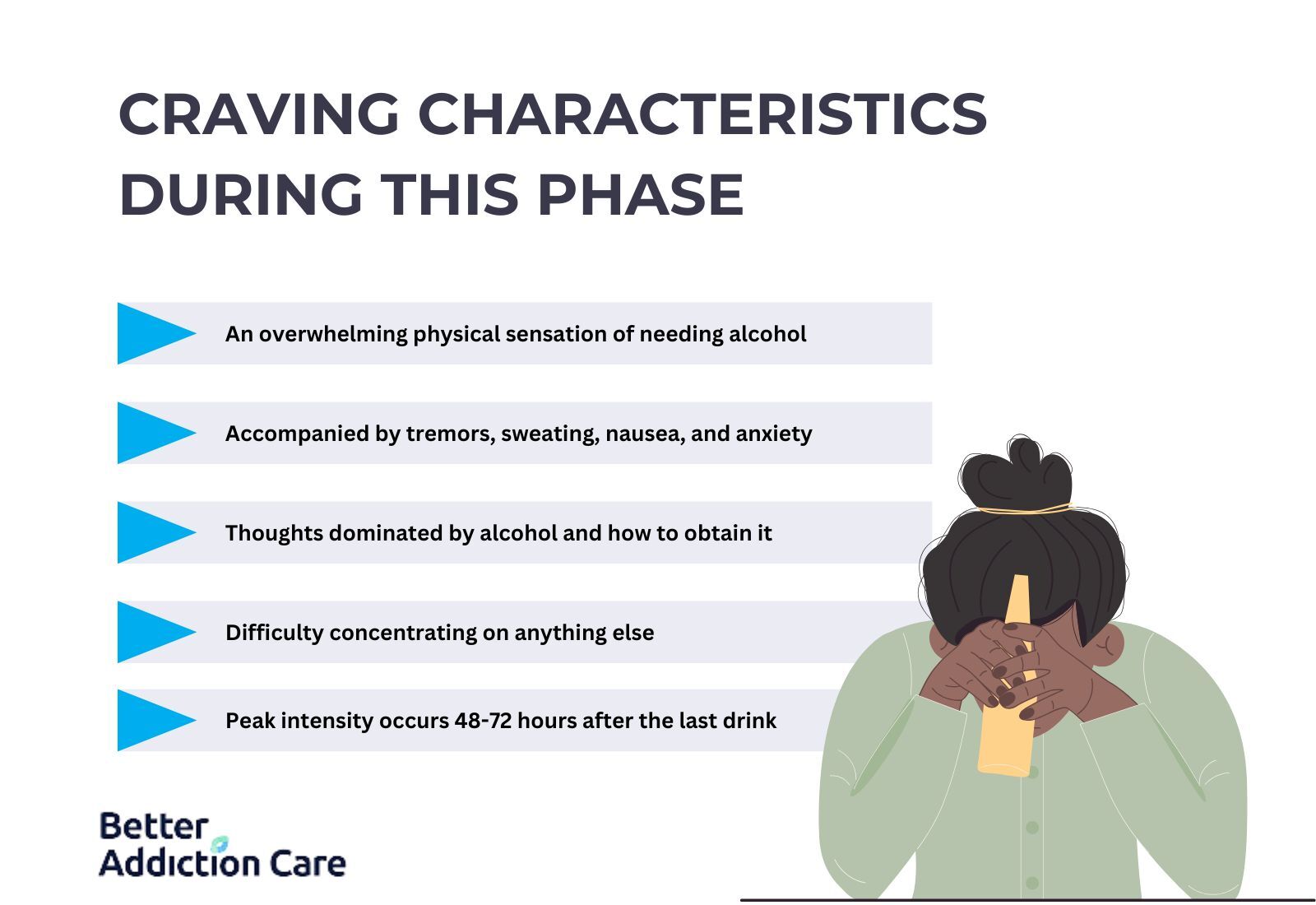
Craving characteristics during this phase include the following.
-
An overwhelming physical sensation of needing alcohol
-
Accompanied by tremors, sweating, nausea, and anxiety
-
Thoughts dominated by alcohol and how to obtain it
-
Difficulty concentrating on anything else
-
Peak intensity occurs 48-72 hours after the last drink
Days 3-7: The Intensity Plateau
The craving sensation is likely to intensify by about 5 to 7 days after the last drink, coinciding with other acute withdrawal symptoms[3]. This is often the most challenging period for individuals attempting to quit without medical support.
Critical insight: This is not the time to rely on willpower alone. The brain's decision-making capacity is severely compromised, and medical supervision may be necessary to safely navigate this phase.
Week 2: The First Relief
After the intense physical strain of withdrawal, people will often be fatigued, but physical symptoms generally resolve by the middle of week two.
Many individuals experience their first significant relief from intense cravings during this period.
What this means for recovery: The lessening of physical cravings doesn't mean the brain has healed; it means the acute chemical crisis has stabilized. This is when many people mistakenly believe they're "cured" and let their guard down.
Phase 2: Post-Acute Withdrawal Syndrome (PAWS) - (Weeks 2-26)
Post-Acute Withdrawal Syndrome (PAWS) refers to lingering withdrawal symptoms that can occur weeks or months after stopping substance use.
This phase is often misunderstood because it doesn't follow the predictable intensity of acute withdrawal.
PAWS involves predominantly negative affect, which develops in early abstinence and can persist for 4–6 months or longer, with symptoms including anxiety, dysphoria, anhedonia, sleep disturbance, cognitive impairment, cravings, and irritability.
A study by Mona Yaser Alsheikh, titled "Post-Acute Withdrawal Syndrome: The Major Cause of Relapse among Psychoactive Substances Addicted Users", published in 2021 in the journal Archives of Pharmacy Practice, found that PAWS symptoms such as cravings, anxiety, irritability, and sleep disturbances can persist from 4 weeks to 6 months or longer. The study emphasizes that this phase plays a critical role in relapse, especially when individuals lack coping mechanisms or support systems.
Weeks 2-8: The Roller Coaster Phase
During this period, cravings become less physically intense but more unpredictable. Many individuals describe this as "waves" of cravings that come and go without obvious triggers.
Brain science explanation: The brain is actively rewiring itself, creating new neural pathways to replace alcohol-dependent systems. This process creates fluctuating symptoms as different brain regions heal at different rates.
Listed below are PAWS craving characteristics.
-
Less physically intense than the acute phase
-
More psychological and emotional in nature
-
Triggered by stress, fatigue, or emotional upheaval
-
May include strong urges followed by periods of relative calm
-
Often accompanied by mood swings, sleep disturbances, and anxiety
Months 3-6: The Deep Rewiring Period
This is when the brain's prefrontal cortex, responsible for decision-making and impulse control, begins significant recovery. Many individuals notice improved ability to think through cravings rather than being overwhelmed by them.
Post-acute withdrawal symptoms typically last between 1 and 2 years; however, the severity and frequency of symptoms tend to dissipate over time without substance use.
Around month 3-4, many people report their first experience of going multiple days without thinking about alcohol. This is a neurological milestone indicating significant brain healing.
Phase 3: Long-Term Psychological Cravings (Months 6+)
The Nature of Long-Term Cravings
After six months of sobriety, most individuals experience a dramatic reduction in spontaneous cravings [4].
However, environmentally or emotionally triggered cravings can still occur, sometimes with surprising intensity.
The brain recalibration process takes anywhere from six months to two years before the brain once again naturally produces endorphins and dopamine. During this extended healing period, cravings shift from neurochemical desperation to psychological habit patterns.
Common Long-Term Triggers:
-
Social situations where alcohol was previously consumed
-
Emotional stress that previously led to drinking
-
Celebratory moments are historically marked with alcohol
-
Seasonal or anniversary dates associated with drinking
-
Interpersonal conflicts that alcohol was used to escape
The "Ghost Limb" Phenomenon
Many individuals in long-term recovery describe cravings as similar to phantom limb syndrome; Alcohol affects the brain so much that the brain occasionally "remembers" alcohol as a solution to problems, even when the logical mind knows better.
What are the Individual Factors That Influence Craving Duration?
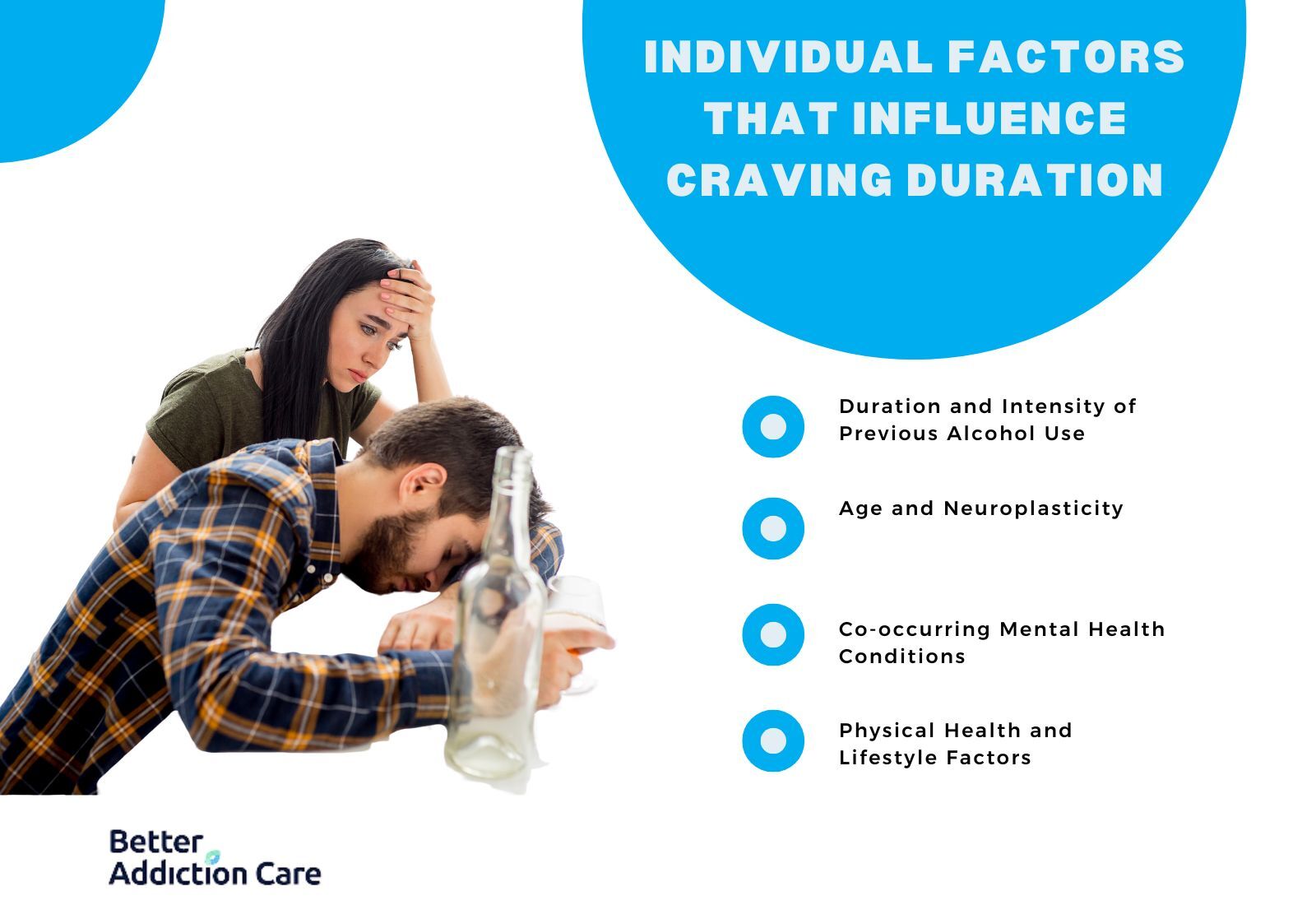
1. Duration and Intensity of Previous Alcohol Use
The table below shows patterns and the stages of alcohol cravings.
2. Age and Neuroplasticity
Younger brains (under 25) often experience more intense initial cravings due to incomplete prefrontal cortex development, but may recover more quickly due to enhanced neuroplasticity.
Older adults (50+) may experience longer PAWS phases but often report better long-term success due to increased motivation and life experience with coping strategies.
3. Co-occurring Mental Health Conditions
Depression: Extends PAWS phase by 2-6 months as the brain must simultaneously heal from alcohol dependence and restore natural mood regulation.
Anxiety disorders: May intensify craving frequency during stress periods, extending the psychological craving phase.
Trauma/PTSD: Significantly complicates recovery timelines, often requiring specialized treatment approaches and extended support.
4. Physical Health and Lifestyle Factors
Factors that accelerate craving resolution.
-
Regular exercise (increases natural endorphin production)
-
Adequate sleep (7-9 hours nightly supports brain healing.)
-
Proper nutrition (B vitamins, omega-3s support neurotransmitter production)
-
Stress management techniques
-
Strong social support systems
Factors that prolong cravings.
-
Chronic stress (interferes with brain healing)
-
Poor sleep habits
-
Inadequate nutrition
-
Social isolation
-
Untreated physical health conditions
When does Alcohol Craving Signal a Problem? (Red Flags to Watch)
While cravings are normal during recovery, certain patterns indicate the need for professional intervention.
Immediate Concern Signals:
-
Cravings accompanied by suicidal thoughts
-
Inability to function at work or in relationships due to craving intensity
-
Cravings leading to other substance use
-
Physical symptoms persisting beyond 2 weeks
-
Severe depression or anxiety accompanying cravings
Extended Recovery Concerns:
-
No improvement in craving intensity after 3 months
-
Increasing craving frequency after 6 months of improvement
-
Cravings triggered by minimal stress after 12+ months
-
Development of new compulsive behaviors
When to Seek Professional Help?
Immediate needs:
-
Unable to safely stop drinking without medical supervision
-
History of withdrawal seizures or delirium tremens
-
Co-occurring mental health conditions
-
Multiple failed quit attempts
Ongoing support needs:
-
PAWS symptoms interfering with daily function
-
Lack of a social support system
-
High-stress life circumstances
-
Desire for a structured recovery program
When these signs appear, it’s advisable to seek professional addiction care support. They specialize in connecting individuals with free, confidential addiction support, including therapy, rehab programs, and medication-assisted treatment. Their team helps people understand their cravings, identify triggers, and find tailored recovery options.
Frequently Asked Questions
Listed below are frequently asked questions on how long Alcohol cravings last.
Do alcohol cravings ever completely go away?
For most people, intense daily cravings resolve within 3-6 months. However, occasional situational or emotional cravings may occur for months or years. The key difference is that long-term cravings become manageable experiences rather than overwhelming compulsions.
Why do I still have cravings after months of sobriety?
Post-acute withdrawal symptoms, including cravings, can persist for 4–6 months or longer. This is normal brain healing, not a sign of failure. Your brain is actively rewiring itself to function without alcohol.
Are there specific times of day when cravings are worse?
Many people experience stronger cravings during their previous drinking times (often evenings) or during high-stress periods. Identifying these patterns helps in developing targeted coping strategies.
What's the difference between a craving and just thinking about drinking?
Cravings involve physical sensations and emotional urgency—a feeling that you need to drink. Simply thinking about drinking without distress or compulsion is normal and doesn't indicate a problem.
Should I be worried if my cravings seem to be getting worse after improving?
Temporary increases in cravings can occur during stressful periods, anniversaries of significant events, or hormonal changes. However, if cravings consistently intensify after months of improvement, professional support is recommended.
Can meditation or mindfulness really help with cravings?
Yes. Research shows that mindfulness practices help individuals observe cravings without reacting, reducing their intensity and duration. Regular meditation also supports overall brain healing and stress management.
What should I do when a craving hits unexpectedly?
Use the "SOBER" technique: Stop what you're doing, Observe the craving without judgment, Breathe deeply, Expand your awareness to the present moment, Respond with a predetermined coping strategy rather than reacting impulsively.
A More Hopeful Way to Think About Cravings
Cravings may feel overwhelming in the beginning, but they don’t last forever, and they don’t stay this intense. With each week of recovery, the brain becomes more resilient, more balanced, and more capable of managing triggers.
You’re not waiting for cravings to disappear, you’re building a life where they no longer control you.
Recovery is not a race. It’s a process of healing the brain, rebuilding self-trust, and learning to live in a way that feels meaningful without alcohol. And with the right support, that kind of life is absolutely possible.


